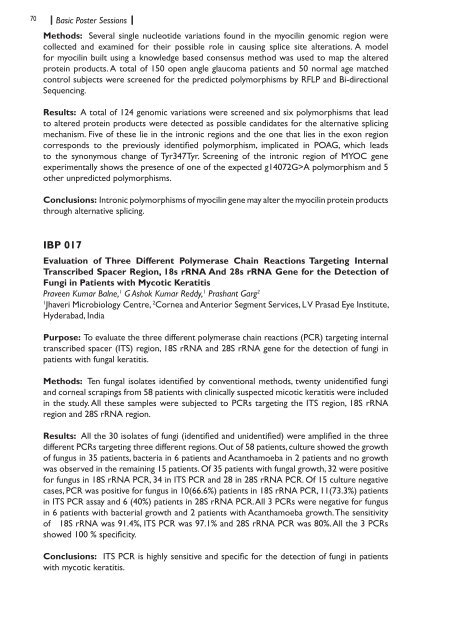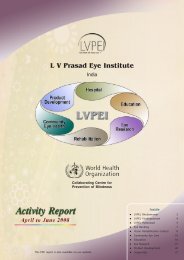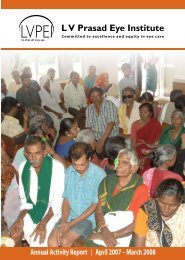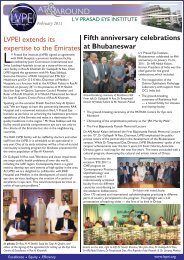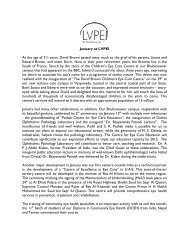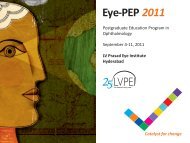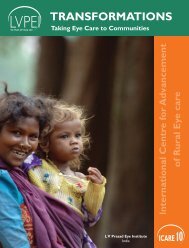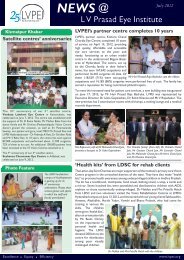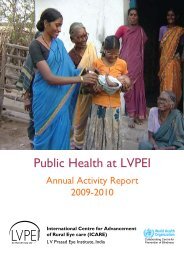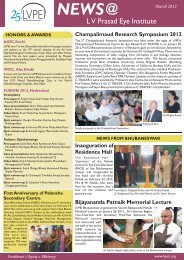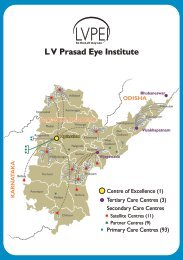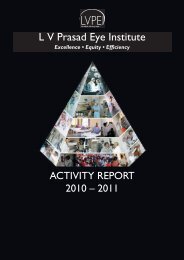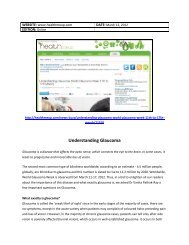IERG Abstracrt Book.indd - LV Prasad Eye Institute
IERG Abstracrt Book.indd - LV Prasad Eye Institute
IERG Abstracrt Book.indd - LV Prasad Eye Institute
You also want an ePaper? Increase the reach of your titles
YUMPU automatically turns print PDFs into web optimized ePapers that Google loves.
70 Basic Poster SessionsMethods: Several single nucleotide variations found in the myocilin genomic region werecollected and examined for their possible role in causing splice site alterations. A modelfor myocilin built using a knowledge based consensus method was used to map the alteredprotein products. A total of 150 open angle glaucoma patients and 50 normal age matchedcontrol subjects were screened for the predicted polymorphisms by RFLP and Bi-directionalSequencing.Results: A total of 124 genomic variations were screened and six polymorphisms that leadto altered protein products were detected as possible candidates for the alternative splicingmechanism. Five of these lie in the intronic regions and the one that lies in the exon regioncorresponds to the previously identified polymorphism, implicated in POAG, which leadsto the synonymous change of Tyr347Tyr. Screening of the intronic region of MYOC geneexperimentally shows the presence of one of the expected g14072G>A polymorphism and 5other unpredicted polymorphisms.Conclusions: Intronic polymorphisms of myocilin gene may alter the myocilin protein productsthrough alternative splicing.IBP 017Evaluation of Three Different Polymerase Chain Reactions Targeting InternalTranscribed Spacer Region, 18s rRNA And 28s rRNA Gene for the Detection ofFungi in Patients with Mycotic KeratitisPraveen Kumar Balne, 1 G Ashok Kumar Reddy, 1 Prashant Garg 21Jhaveri Microbiology Centre, 2 Cornea and Anterior Segment Services, L V <strong>Prasad</strong> <strong>Eye</strong> <strong>Institute</strong>,Hyderabad, IndiaPurpose: To evaluate the three different polymerase chain reactions (PCR) targeting internaltranscribed spacer (ITS) region, 18S rRNA and 28S rRNA gene for the detection of fungi inpatients with fungal keratitis.Methods: Ten fungal isolates identified by conventional methods, twenty unidentified fungiand corneal scrapings from 58 patients with clinically suspected micotic keratitis were includedin the study. All these samples were subjected to PCRs targeting the ITS region, 18S rRNAregion and 28S rRNA region.Results: All the 30 isolates of fungi (identified and unidentified) were amplified in the threedifferent PCRs targeting three different regions. Out of 58 patients, culture showed the growthof fungus in 35 patients, bacteria in 6 patients and Acanthamoeba in 2 patients and no growthwas observed in the remaining 15 patients. Of 35 patients with fungal growth, 32 were positivefor fungus in 18S rRNA PCR, 34 in ITS PCR and 28 in 28S rRNA PCR. Of 15 culture negativecases, PCR was positive for fungus in 10(66.6%) patients in 18S rRNA PCR, 11(73.3%) patientsin ITS PCR assay and 6 (40%) patients in 28S rRNA PCR. All 3 PCRs were negative for fungusin 6 patients with bacterial growth and 2 patients with Acanthamoeba growth. The sensitivityof 18S rRNA was 91.4%, ITS PCR was 97.1% and 28S rRNA PCR was 80%. All the 3 PCRsshowed 100 % specificity.Conclusions: ITS PCR is highly sensitive and specific for the detection of fungi in patientswith mycotic keratitis.


